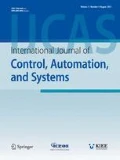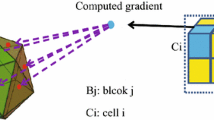Abstract
In dense traffic flow, car occlusion is usually one of the great challenges of vehicle detection and tracking in traffic monitoring systems. Current methods of car hypothesis such as symmetry or shadow based method work only with non-occluded cars. In this paper, we proposed an approach to car detection and counting using a new method of car hypothesis based on car windshield appearance which is the most feasible cue to hypothesize cars in occlusion situations. In hypothesis stage, Hough transformation is used to detect trapezoid-like regions where a car’s windshield could be located, and then candidate car regions are estimated by the windshield region and its size. In verification stage, HOG descriptor and a well-collected dataset are used to train a linear SVM classifier for detecting cars at a high accuracy rate. Then, a tracking process based on Kalman filter is used to track the movement of detected cars in consecutive frames of traffic videos, followed by rule-based reasoning for counting decision. Experimental results on real traffic videos showed that the system is able to detect, track and count multiple cars including occlusion in dense traffic flow in real-time.
Similar content being viewed by others
References
N. Buch, S. A. Velastin, and J. Orwell, “A review of computer vision techniques for the analysis of urban traffic,” IEEE Trans. on Intelligent Transportation Systems, vol. 12, no. 3, pp. 920–939, 2011.
H. Y. Zhao, O. Kim, J. S. Won, and D. J. Kang, “Lane detection and tracking based on annealed particle filter,” International Journal of Control Automation and Systems, vol. 12, no. 6, pp. 1303–1312, 2014.
N. Ben Romdhane, M. Hammami, and H. Ben-Abdallah, A Lane Detection and Tracking Method for Driver Assistance System, Springer Berlin Heidelberg, 2011.
V.-D. Hoang and K.-H. Jo, “Path planning for autonomous vehicle based on heuristic searching using online images,” Vietnam Journal of Computer Science, Open Access, 2014.
C. Kawatsu, J. Li, and C. J. Chung, Obstacle & Lane Detection and Local Path Planning for IGVC Robotic Vehicles Using Stereo Vision, Springer International Publishing, 2014.
M. H. Le, V. D. Hoang, A. Vavilin, and K. H. Jo, “One-point-plus for 5-DOF localization of vehiclemounted omnidirectional camera in long-range motion,” International Journal of Control Automation and Systems, vol. 11, no. 5, pp. 1018–1027, 2013.
T. Bin, Y. Qingming, G. Yuan, W. Kunfeng, and L. Ye, “Video processing techniques for traffic flow monitoring: a survey,” IEEE Conf. on Intelligent Transportation Systems, pp. 1103–1108, 2011.
T. Zielke, M. Brauckmann, and W. Vonseelen, “Intensity and edge-based symmetry detection with an application to car-following,” CVGIP-Image Understanding, vol. 58, no. 2, pp. 177–190, 1993.
S. S. Teoh and T. Braunl, “Symmetry-based monocular vehicle detection system,” Machine Vision and Applications, vol. 23, no. 5, pp. 831–842, 2012.
T. Luo-Wei, J.-W. Hsieh, and F. Kao-Chin, “Vehicle detection using normalized color and edge map,” Proc. of IEEE International Conf. on Image Processing, pp. II-598-601, 2005.
M. Betke, E. Haritaoglu, and L. S. Davis, “Realtime multiple vehicle detection and tracking from a moving vehicle,” Machine Vision and Applications, vol. 12, no. 2, pp. 69–83, 2000.
C. Tzomakas and W. von Seelen, Vehicle Detection in Traffic Scenes Using Shadows, 1998.
T. Bucher, C. Curio, J. Edelbrunner, C. Igel, D. Kastrup, I. Leefken, G. Lorenz, A. Steinhage, and W. von Seelen, “Image processing and behavior planning for intelligent vehicles,” IEEE Trans. on Industrial Electronics, vol. 50, no. 1, pp. 62–75, 2003.
C. Stauffer and W. E. L. Grimson, “Adaptive background mixture models for real-time tracking,” Proc. of IEEE Conf. on Computer Vision and Pattern Recognition, p. 252, 1999.
M. Boninsegna and A. Bozzoli, “A tunable algorithm to update a reference image,” Signal Processing-Image Communication, vol. 16, no. 4, pp. 353–365, 2000.
J. R. Tyrer and L. M. Lobo, “An optical method for automated roadside detection and counting of vehicle occupants,” Proc. of the Institution of Mechanical Engineers Part D-Journal of Automobile Engineering, vol. 222, no. 5, pp. 765–774, 2008.
Y. C. Kuo, N. S. Pai, and Y. F. Li, “Vision-based vehicle detection for a driver assistance system,” Computers & Mathematics with Applications, vol. 61, no. 8, pp. 2096–2100, 2011.
C. Thou-Ho, L. Yu-Feng, and C. Tsong-Yi, “Intelligent vehicle counting method based on blob analysis in traffic surveillance,” Proc. of International Conf. on Innovative Computing, Information and Control, pp. 238–238, 2007.
T. Ying-Li, M. Lu, and A. Hampapur, “Robust and efficient foreground analysis for real-time video surveillance,” Proc. of IEEE Conf. on Computer Vision and Pattern Recognition, pp. 1182–1187 vol. 1181, 2005.
W. Bing-fei, L. Shin-Ping, and C. Yuan-Hsin, “A real-time multiple-vehicle detection and tracking system with prior occlusion detection and resolution,” Proc. of the Fifth IEEE International Symposium on Signal Processing and Information Technology, pp. 311–316, 2005.
H. Fujiyoshi and T. Kanade, “Layered detection for multiple overlapping objects,” IEICE Trans. on Information and Systems, Vol. E87d, no. 12, pp. 2821–2827, 2004.
R. S. Feris, B. Siddiquie, J. Petterson, Y. Zhai, A. Datta, L. M. Brown, and S. Pankanti, “Large-scale vehicle detection, indexing, and search in urban surveillance videos,” IEEE Trans. on Multimedia, vol. 14, no. 1, pp. 28–42, 2012.
S. Gupte, O. Masoud, R. F. K. Martin, and N. P. Papanikolopoulos, “Detection and classification of vehicles,” IEEE Trans. on Intelligent Transportation Systems, vol. 3, no. 1, pp. 37–47, 2002.
C. C. C. Pang, W. W. L. Lam, and N. H. C. Yung, “A method for vehicle count in the. presence of multiple-vehicle occlusions in traffic images,” IEEE Trans. on Intelligent Transportation Systems, vol. 8, no. 3, pp. 441–459, 2007.
A. Ghasemi and R. Safabakhsh, “A real-time multiple vehicle classification and tracking system with occlusion handling,” Proc. of IEEE International Conf. on Intelligent Computer Communication and Processing, pp. 109–115, 2012.
N. Dalal and B. Triggs, “Histograms of oriented gradients for human detection,” Proc. of IEEE Conf. on Computer Vision and Pattern Recognition, pp. 886–893, 2005.
J. Canny, “A computational approach to edge detection,” IEEE Trans. on Pattern Analysis and Machine Intelligence, vol. 8, no. 6, pp. 679–698, 1986.
R. O. Duda and P. E. Hart, “Use of the Hough transformation to detect lines and curves in pictures,” Communications of the ACM, vol. 15, no. 1, pp. 11–15, 1972.
V. F. Leavers, “Which Hough transform?,” CVGIP: Image Understanding, vol. 58, no. 2, pp. 250–264, 1993.
Y. Furukawa and Y. Shinagawa, “Accurate and robust line segment extraction by analyzing distribution around peaks in Hough space,” Computer Vision and Image Understanding, vol. 92, no. 1, pp. 1–25, 2003.
P. F. Felzenszwalb, R. B. Girshick, D. McAllester, and D. Ramanan, “Object detection with discriminatively trained part-based models,” IEEE Trans. on Pattern Analysis and Machine Intelligence, vol. 32, no. 9, pp. 1627–1645, 2010.
V. D. Hoang, M. H. Le, and K. H. Jo, “Hybrid cascade boosting machine using variant scale blocks based HOG features for pedestrian detection,” Neurocomputing, vol. 135, no. 5, pp. 357–366, 2014.
T. Gandhi and M. M. Trivedi, “Video based surround vehicle detection, classification and logging from moving platforms: issues and approaches,” Proc. of IEEE Intelligent Vehicles Symposium, pp. 1067–1071, 2007.
Open CV, Intel’s Computer Vision Library, Open Source, 2012.
K. R. Muller, S. Mika, G. Ratsch, K. Tsuda, and B. Scholkopf, “An introduction to kernel-based learning algorithms,” IEEE Trans. on Neural Networks, vol. 12, no. 2, pp. 181–201, 2001.
M. Ling, X. Mei, H. Yi, and Z. Yuefei, “Preceding vehicle detection using histograms of oriented gradients,” Proc. of International Conf. on Communications, Circuits and Systems, pp. 354–358, 2010.
Author information
Authors and Affiliations
Corresponding author
Additional information
Recommended by Associate Editor Kang-Hyun Jo under the direction of Editor Duk-Sun Shim.
This work was supported by the 2014 Research Fund of University of Ulsan, Korea.
Van Huy Pham received his B.S degree in Mathematics and Informatics from Can Tho University, Can Tho, Vietnam, in 2003, and his Master’s degree in Computer Science from University of Sciences, Ho Chi Minh City, Vietnam in 2007. In 2010, he joined Intelligent Mechatronics Laboratory to pursue a Ph.D. degree from the School of Mechatronics and Automotive Engineering, University of Ulsan, Ulsan, Korea. His current research interests include computer vision, image processing, machine learning, and intelligence transportation system.
Byung-Ryong Lee received his B.S. and M.S. degrees in Mechanical Engineering from Busan National University, Busan, Korea, in 1983 and 1988, respectively, and his Ph.D. degree in Mechanical Engineering from North Carolina State University, Raleigh, USA, in 1994. Since 1995, he has been with the Faculty of Engineering, University of Ulsan, Ulsan, Korea, where he is currently a Professor in Mechanical Engineering. His main research interests include robotics, especially bio-inspired robotics, fault detection and monitoring using machine-vision, and intelligent control application incorporating fuzzy, neural network, and genetic algorithm. Prof. Lee is a member of the Society of Mechanical Engineering of Korea (KSME), the Society of Precision Engineering of Korea (KSPE), and the Institute of Control, Robotics, and Systems (ICROS).
Rights and permissions
About this article
Cite this article
Van Pham, H., Lee, BR. Front-view car detection and counting with occlusion in dense traffic flow. Int. J. Control Autom. Syst. 13, 1150–1160 (2015). https://doi.org/10.1007/s12555-014-0229-7
Received:
Revised:
Accepted:
Published:
Issue Date:
DOI: https://doi.org/10.1007/s12555-014-0229-7




